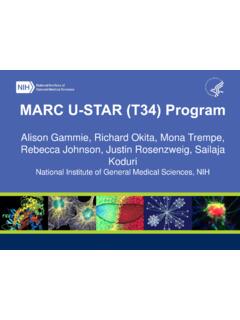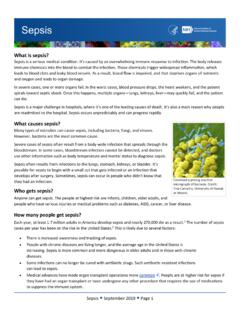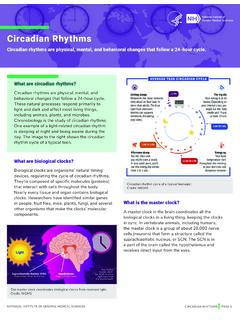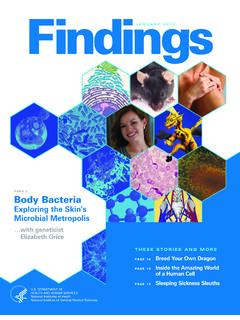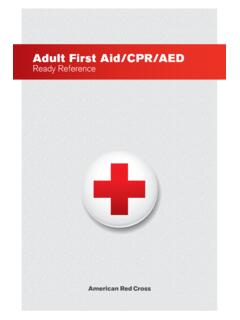Transcription of What is a burn?
1 what is a burn ? A burn is tissue damage caused by heat, chemicals, electricity, sunlight, or nuclear radiation. The most common burns are those caused by hot liquid or steam, building fires, and flammable liquids and gases. Burns are defined by how deep they are and how large an area they cover. A large burn injury is likely to include burned areas of different depths. Deep burns heal more slowly, are more difficult to treat, and are more prone to complications such as infections and scarring. Very deep Cross-section of skin anatomy shows layers and burns are the most life-threatening of all and may different tissue types. Credit: NIGMS. require amputation. Types of burns include: First-degree burns damage the outer layer (epidermis) of the skin. These burns usually heal on their own within a week. A common example is a sunburn. Second-degree burns damage not only the outer layer but also the layer beneath it (dermis).
2 These burns might need a skin graft natural or artificial skin to cover and protect the body while it heals and they may leave a scar. Third-degree burns damage or completely destroy both layers of skin including hair follicles and sweat glands and damage underlying tissues. These burns always require skin grafts. Fourth degree burns extend into fat, fifth degree burns into muscle, and sixth degree burns to bone. How does the body react to a severe burn ? Severe burns cause serious, body-wide problems. At the root of most of these problems is the body's explosive inflammatory response. A normal inflammatory response protects the body from invaders, such as bacteria, viruses, fungi, cancerous cells, toxins, and foreign materials. It activates in response to infection, injury, or other threat. It is designed to destroy the cause of the problem, contain the damage, and clean up the mess left by dead cells and other debris.
3 But when faced with large or deep burns, it can overreact, often making the injury more severe and harming the heart, lungs, blood vessels, kidneys, and other organ systems. During this inflammatory response, there is fluid loss that can cause a sharp and potentially deadly drop in blood pressure known as shock. Fluid can also become trapped inside the body, leading to swelling known as edema. If tissues and organs do not receive enough oxygen because of shock, edema, or something else, they suffer damage and can fail. The lungs, heart, brain, and kidneys are particularly susceptible. Burns January 2018 Page 1. Infection is also a major concern. Burns damage the skin's protective barrier, meaning bacteria and other foreign invaders can sneak in. Burns also weaken the immune system, so the body is less able to fight off threats. Infections can take hold not only in the injured area, but also in organs such as the lungs (pneumonia) and bloodstream (sepsis), where they are potentially lethal.
4 How are burns treated? In many cases, health care providers cover the burned area using sterile bandages with topical antibiotics (skin creams or ointments) or long-acting, silver-containing dressings to prevent infection. For third-degree burns and some second-degree ones, patients need extra fluids to maintain blood pressure and prevent shock. Surgeons may treat large burns by removing burned tissue and covering the burn wound Credit: iStock with a skin graft. Depending on the severity, location, and nature of a burn , doctors may treat the injury with a combination of natural skin grafts, artificial skin products, and laboratory-grown epidermis. Injured body parts need to be exercised to maintain their functionality and range of motion. People with minor burns may be treated at their local hospital. Those with more serious burns might be transferred to a hospital with a special burn unit.
5 Serious burns include any burns that are likely to lead to impaired physical or psychological recovery. The american burn Association maintains a searchable list of verified burn centers in the what is the prognosis for people who have severe burns? A few decades ago, burns covering half the body were often fatal. Now, thanks to research a large portion of it supported by the National Institute of General Medical Sciences (NIGMS) . people with burns covering 90 percent of their bodies can survive, although they often have permanent impairments and scars. what kinds of burn research does NIGMS support? NIGMS funds research on how the body responds to and recovers from burns, the best ways to treat these injuries, and the long-term physiological outcomes of people who have been burned. For example, an NIGMS-funded project designed to understand the body's response to major injury revealed that the bodies of burn survivors require a year or more to recover.
6 Researchers have also learned how to replace skin by growing epidermal skin cells in a laboratory and by developing artificial skin products that can temporarily protect the burned area while the body heals. Past research has revealed new and better ways to replenish fluids, clean wounds, control infection, support nutrition, and minimize pain. Research continues in these areas. Burns January 2018 Page 2. Where can I find more information about burns? Learn More The Model Systems Knowledge Translation Center is a NIGMS Resources federally funded consortium of experts in burn recovery, prevention, and education. Biomedical Beat Blog The american burn Association is a nonprofit health Posts on Burns association dedicated to addressing the problems of burn injuries For Janice: Legacy of a and burn survivors throughout the United States, Canada, and Short Life from Findings other countries.
7 Magazine The Phoenix Society for burn Survivors is an international, nonprofit organization helping burn survivors and their families. Sepsis Fact Sheet Shriners Hospitals for Children is a nationwide network of Other Resources hospitals that provide orthopedic and burn care to children under 18 years of age, regardless of financial need. Burns (NIH). NIH News in Health: A. NIGMS does not provide specific medical advice, but rather provides users Burning Issue: Handling with information to help them better understand health and disease. Please consult with a qualified health care professional for answers to Household burns personal medical questions. burn Prevention (CDC). NIGMS is a part of the National Institutes of Health that supports basic research to increase our understanding of biological processes and lay the foundation for advances in disease diagnosis, treatment and prevention.
8 For more information on the Institute's research and training programs, see Content revised January 2018. Burns January 2018 Page 3.

